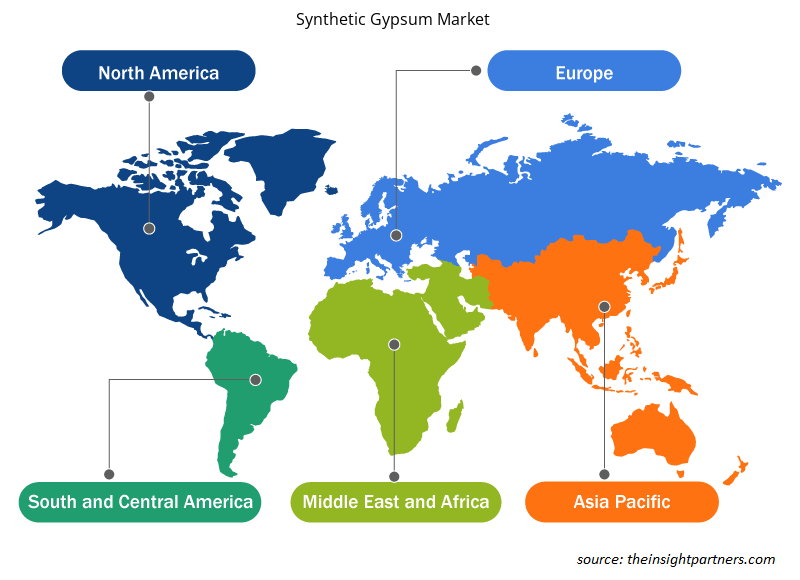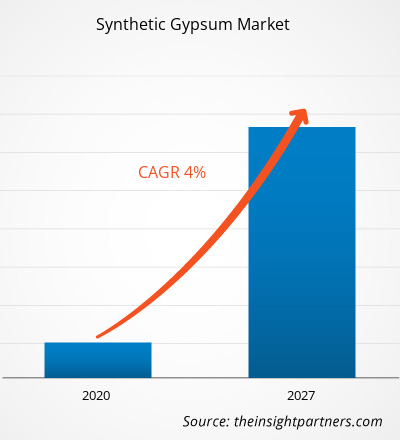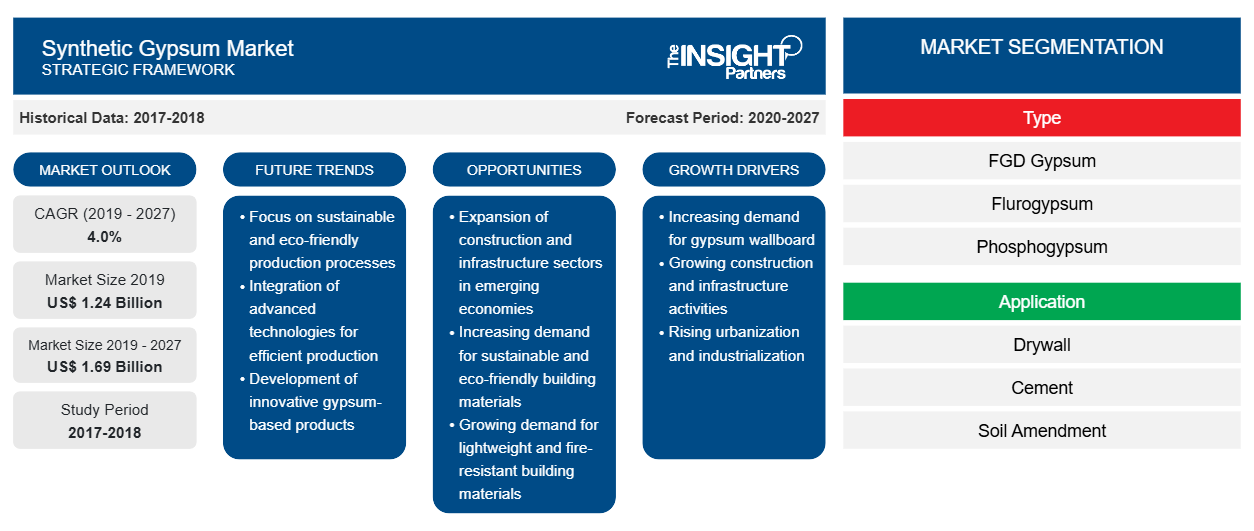[Informe de investigación] El mercado mundial de yeso sintético se valoró en US$ 1.244,02 millones en 2019 y se proyecta que alcance los US$ 1.693,72 millones para 2027; se espera que crezca a una CAGR del 4,0% entre 2020 y 2027.
El yeso sintético se utiliza principalmente en la construcción y en la agricultura. El crecimiento de la industria de la construcción en todo el mundo ha aumentado la demanda de estructuras decorativas y paneles de yeso, lo que ha impulsado la demanda de yeso sintético. Además, el uso de yeso sintético como relleno en el proceso de producción de cemento refuerza el crecimiento del mercado de yeso sintético.
En 2019, América del Norte contribuyó con la mayor participación en el mercado mundial de yeso sintético. El crecimiento del mercado en América del Norte se atribuye a la creciente industria de la construcción en los EE. UU. y al surgimiento de varias empresas de sistemas FGD en América del Norte. Debido a la creciente urbanización e industrialización, las actividades de construcción en la región están aumentando. Esto está estimulando la demanda de proyectos de renovación urbana, lo que impulsa la demanda de yeso sintético que se utiliza para fabricar cemento, paneles de yeso y estructuras decorativas.
El brote de COVID-19 está afectando negativamente a las economías e industrias en varios países debido a los confinamientos, las prohibiciones de viaje y los cierres de empresas. La industria mundial de productos químicos y materiales es una de las principales industrias que sufre graves perturbaciones, como interrupciones de la cadena de suministro, cancelaciones de eventos tecnológicos y cierres de oficinas. Por ejemplo, China es el centro de fabricación mundial y el mayor proveedor de materias primas para varias industrias, y también es uno de los países más afectados. El cierre de varias plantas y fábricas en China está restringiendo las cadenas de suministro globales e interrumpiendo las actividades de fabricación, los cronogramas de entrega y las ventas de diversos productos químicos y materiales. Varias empresas ya han anunciado posibles retrasos en las entregas de productos y una caída en las ventas futuras de sus productos. Además, las prohibiciones de viaje globales impuestas por países de Europa, Asia y América del Norte están obstaculizando las colaboraciones comerciales y las oportunidades de asociación. Todos estos factores están obstaculizando la industria de productos químicos y materiales y, por lo tanto, actúan como factores restrictivos para el crecimiento de varios mercados relacionados con esta industria.
Personalice este informe según sus necesidades
Obtendrá personalización en cualquier informe, sin cargo, incluidas partes de este informe o análisis a nivel de país, paquete de datos de Excel, así como también grandes ofertas y descuentos para empresas emergentes y universidades.
- Obtenga las principales tendencias clave del mercado de este informe.Esta muestra GRATUITA incluirá análisis de datos, desde tendencias del mercado hasta estimaciones y pronósticos.
Perspectivas del mercado
Demanda creciente de la industria de la construcción
La demanda de yeso sintético ha ido en aumento en la industria de la construcción. En la industria de la construcción, el yeso sintético se utiliza principalmente como material de relleno para el cemento y los yesos para mejorar su resistencia y también para reducir el tiempo de fraguado del hormigón. También se utiliza para hacer paneles decorativos y yeso de París. El yeso FGD, que es uno de los tipos de yeso sintético, se utiliza principalmente en la industria de la construcción para fabricar cemento, paneles de yeso y yeso de París. El yeso FGD es básicamente reciclable por naturaleza y, por lo tanto, es utilizado principalmente por los fabricantes. El yeso de París se utiliza básicamente para hacer paneles decorativos, estructuras y esculturas. La demanda de estas estructuras y esculturas está aumentando en la industria de la construcción, lo que está provocando un aumento en la demanda de yeso sintético. Los gobiernos de muchos países en desarrollo se están centrando en el desarrollo y la mejora de su infraestructura y están introduciendo muchas reformas y regulaciones que ayudarán a impulsar las industrias inmobiliaria y de infraestructura. Se espera que todas estas regulaciones y reformas tengan un impacto positivo en la industria de la construcción, lo que impulsaría la demanda de yeso sintético en el período de pronóstico.
Tipo de información
Según el tipo, el mercado de yeso sintético se segmenta en yeso FGD, yeso fluorado, yeso fosforado, yeso citral y otros. El segmento de yeso FGD lideró el mercado con la mayor participación en 2019.El yeso FGD es básicamente el yeso obtenido de los sistemas de desulfuración de gases de combustión. El azufre se elimina principalmente de los gases de combustión, lo que se puede hacer con la ayuda de cal en el sistema de desulfuración de gases de combustión. El yeso FGD tiene en su mayoría la misma identidad química que la de un yeso natural, y se considera un yeso de mayor pureza. El uso de yeso FGD se considera ecológicamente beneficioso. El yeso FGD tiene aplicaciones agrícolas y se puede utilizar en condiciones de suelo e hidrogeológicas con el fin de conservar el suelo y reciclar material industrial. El proceso mediante el cual se fabrica el yeso FGD es ecológico y proporciona una fuente ecológica de yeso puro. El yeso FGD tiene varias aplicaciones en procesos como la producción de cemento, el tratamiento del agua, la fabricación de vidrio, las aplicaciones mineras, los productos de paneles de yeso, la construcción de carreteras y la agricultura. También se puede utilizar como fuente de nutrición para los cultivos.
Algunos de los actores clave que operan en el mercado del yeso sintético son Drax Group PLC, American Gypsum, USG Corporation, Larargeholcim, Travancore Titanium Products Limited, Knauf Gips KG, Transparent Technologies Limited, BauMineral GMBH, Steag GMBH y Boral. Los principales actores del mercado se están centrando en estrategias como fusiones y adquisiciones, y lanzamientos de productos para expandir su presencia geográfica y su base de consumidores a nivel mundial.
Perspectivas regionales del mercado del yeso sintético
Los analistas de Insight Partners explicaron en detalle las tendencias y los factores regionales que influyen en el mercado de yeso sintético durante el período de pronóstico. Esta sección también analiza los segmentos y la geografía del mercado de yeso sintético en América del Norte, Europa, Asia Pacífico, Oriente Medio y África, y América del Sur y Central.

- Obtenga datos regionales específicos para el mercado de yeso sintético
Alcance del informe de mercado de yeso sintético
| Atributo del informe | Detalles |
|---|---|
| Tamaño del mercado en 2019 | 1.240 millones de dólares estadounidenses |
| Tamaño del mercado en 2027 | 1.690 millones de dólares estadounidenses |
| CAGR global (2019-2027) | 4.0% |
| Datos históricos | 2017-2018 |
| Período de pronóstico | 2020-2027 |
| Segmentos cubiertos | Por tipo
|
| Regiones y países cubiertos | América del norte
|
| Líderes del mercado y perfiles de empresas clave |
|
Densidad de los actores del mercado de yeso sintético: comprensión de su impacto en la dinámica empresarial
El mercado del yeso sintético está creciendo rápidamente, impulsado por la creciente demanda de los usuarios finales debido a factores como la evolución de las preferencias de los consumidores, los avances tecnológicos y una mayor conciencia de los beneficios del producto. A medida que aumenta la demanda, las empresas amplían sus ofertas, innovan para satisfacer las necesidades de los consumidores y aprovechan las tendencias emergentes, lo que impulsa aún más el crecimiento del mercado.
La densidad de actores del mercado se refiere a la distribución de las empresas o firmas que operan dentro de un mercado o industria en particular. Indica cuántos competidores (actores del mercado) están presentes en un espacio de mercado determinado en relación con su tamaño o valor total de mercado.
Las principales empresas que operan en el mercado de yeso sintético son:
- Grupo Drax PLC
- Yeso americano
- Corporación USG
- Larargeholcim
- Productos de titanio Travancore Limited
Descargo de responsabilidad : Las empresas enumeradas anteriormente no están clasificadas en ningún orden particular.

- Obtenga una descripción general de los principales actores clave del mercado de yeso sintético
Informe Destacado
- Tendencias progresivas de la industria en el mercado mundial de yeso sintético para ayudar a los actores a desarrollar estrategias efectivas a largo plazo
- Estrategias de crecimiento empresarial adoptadas por los mercados desarrollados y en desarrollo
- Análisis cuantitativo del mercado mundial de yeso sintético de 2017 a 2027
- Estimación de la demanda de yeso sintético en diversas industrias
- Análisis PEST para ilustrar la eficacia de los compradores y proveedores que operan en la industria para predecir el crecimiento del mercado
- Desarrollos recientes para comprender el escenario competitivo del mercado y la demanda de yeso sintético
- Tendencias y perspectivas del mercado junto con los factores que impulsan y restringen el crecimiento del mercado de yeso sintético
- Proceso de toma de decisiones mediante la comprensión de las estrategias que sustentan el interés comercial con respecto al crecimiento del mercado mundial de yeso sintético
- Tamaño del mercado de yeso sintético en varios nodos del mercado
- Descripción detallada y segmentación del mercado mundial de yeso sintético, así como su dinámica en la industria.
- Tamaño del mercado de yeso sintético en varias regiones con oportunidades de crecimiento prometedoras
Mercado de yeso sintético por tipo
- Yeso FGD
- Yeso fluorado
- Yeso fosforado
- Citroyeso
- Otros
Mercado de yeso sintético por aplicación
- Paneles de yeso
- Cemento
- Enmienda del suelo
- Dental
- Tratamiento de agua
- Otros
Perfiles de empresas
- Grupo Drax PLC
- Yeso americano
- Corporación USG
- Larargeholcim
- Productos de titanio Travancore Limited
- Knauf Yeso KG
- Tecnologías transparentes limitadas
- BauMineral GMBH
- Steag GmbH
- Boral
- Análisis histórico (2 años), año base, pronóstico (7 años) con CAGR
- Análisis PEST y FODA
- Tamaño del mercado, valor/volumen: global, regional y nacional
- Industria y panorama competitivo
- Conjunto de datos de Excel
Informes recientes
Testimonios
Razón para comprar
- Toma de decisiones informada
- Comprensión de la dinámica del mercado
- Análisis competitivo
- Información sobre clientes
- Pronósticos del mercado
- Mitigación de riesgos
- Planificación estratégica
- Justificación de la inversión
- Identificación de mercados emergentes
- Mejora de las estrategias de marketing
- Impulso de la eficiencia operativa
- Alineación con las tendencias regulatorias





















 Obtenga una muestra gratuita para - Mercado de yeso sintético
Obtenga una muestra gratuita para - Mercado de yeso sintético